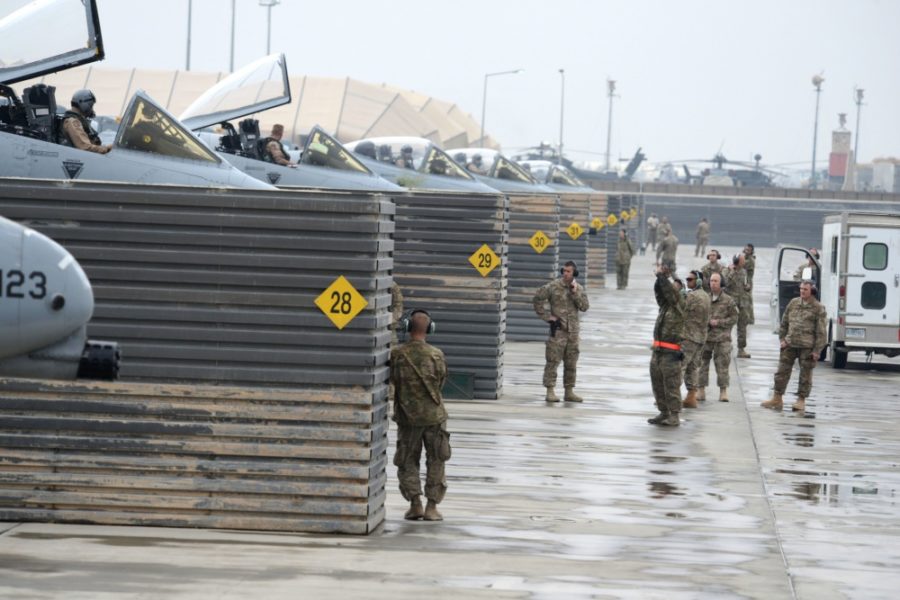Looters were left to enter and take what remained of Bagram Airfield in Afghanistan after U.S. forces withdrew July 1 without fanfare or an official announcement.
“The silence was deafening,” Florida Congressman and Afghan war veteran Rep. Mike Waltz told Air Force Magazine on July 2, describing his thoughts when he heard the news that America’s most important base in Afghanistan has been fully vacated.
“The thing that strikes me was that this was the first place that you came every deployment. That was the last place that you saw when you left to go home,” said the former Green Beret, who recalled attending ramp ceremonies at Bagram to view flag-draped coffins loaded on Air Force transports to go home.
“It’s just really, I think, symbolic and emotional for a lot of people,” he added. “Not even an official announcement, nothing. It just is, you know, like I said, closed with a whimper, that was really, just left me with very mixed emotions.”
The sprawling base served as the hub for American operations for about 20 years, hosting hundreds of thousands of American troops and scores of USAF combat deployments. The base grew to 30 square miles, its runway was 12,000 feet long, and it had more than 110 revetments and a village that had hosted fast food restaurants and other amenities for troops.
The Air Force’s 455th Air Expeditionary Wing oversaw the base, first activating in April 2002 with A-10s beginning to fly from Bagram in the early months of the war. Now, with no combat aircraft based in the country, American military leaders say air support will be provided from “over the horizon.” Pentagon leaders have said that means MQ-9 Reaper missions departing from the Persian Gulf until the U.S. government identifies a closer basing option.
Afghanistan Withdrawal Will be Complete by August
As of June 28, the Defense Department had flown out 896 C-17 loads of equipment from Afghanistan, largely from Bagram. The base is the seventh facility to be handed over to the Afghan Ministry of Defense.
The local district administrator for Bagram told The Associated Press that the last U.S. forces left the base overnight and did not coordinate with local officials, and as a result looters were able to enter the base early July 2.
The withdrawal from Bagram is a major step in the total retrograde from Afghanistan, which President Joe Biden said in April would be completed by Sept. 11, though the Pentagon indicated July 2 that full withdrawal will wrap up by the end of August.
Defense Secretary Lloyd J. Austin III met with the defense minister of Uzbekistan on July 1 and with his counterpart from Tajikistan on July 2. At both meetings, officials discussed the possibility of a U.S. basing agreement on Afghanistan’s northern border, without which the Afghanistan counterterrorism mission requires a four-hour commute each way from Gulf bases.
Taliban Make Advances
As American forces vacated Bagram, so, too, did close air support to the Afghan Armed Forces fighting the Taliban.
In recent weeks, security experts say the loss of U.S. air support has allowed the Taliban to make advances across the country. In his visit to Washington, D.C., on June 25, Afghan President Ashraf Ghani implored American leaders for continued close air support through the summer fighting season into September, Waltz said.
“It was critical to Afghan security forces because that’s where the majority of our close air support came from,” said Waltz, who had dinner with Ghani during his visit to the capital.
“The bottom line from the president of Afghanistan was that air power was key to stem the Taliban advances,” he added. “The Taliban are out in the open now, and he was confident their momentum could be stopped with continued air power.”
In advance of the withdrawal, Austin ordered B-52s to deploy to Al Udeid Air Base, Qatar, and the aircraft carrier USS Eisenhower offshore to provide air support for U.S. troops and allies as they exited the country. Pentagon spokesman John F. Kirby confirmed July 2 that with the closure of Bagram “strike capabilities … are no longer in Afghanistan,” though “some aviation elements” remain in Kabul.
Kirby also said command authority for U.S. Forces-Afghanistan will transition in the coming weeks from Gen. Austin S. Miller to commander of U.S. Central Command, Gen. Kenneth F. McKenzie Jr.
Additionally, Austin approved the creation of U.S. Forces Afghanistan-Forward with Rear Adm. Peter G. Vasely taking command. Vasely, currently the commander of Special Operations Joint Task Force-Afghanistan, will be responsible for protection of the U.S. Embassy and other American personnel in Kabul. Also, Brig. Gen. Curtis A. Buzzard, currently the director of the Defense Security Cooperation Management Office-Afghanistan, will administer funding and other logistical support to the Afghan military from Qatar, Kirby said.
The Pentagon has emphasized that counterterrorism capabilities will still be conducted from “over the horizon,” but Waltz has his doubts.
“I think the over the horizon is a talking point, and it is a little bit of a pipe dream,” Waltz said. “The reality without local allies on the ground, without local intelligence on the ground, without a base in country, the distances involved—or, in the region for that matter—the distances involved from the Gulf makes it incredibly complicated.”
